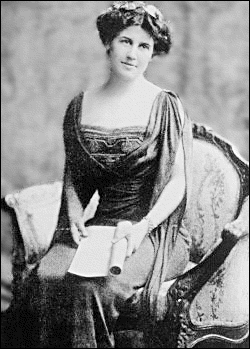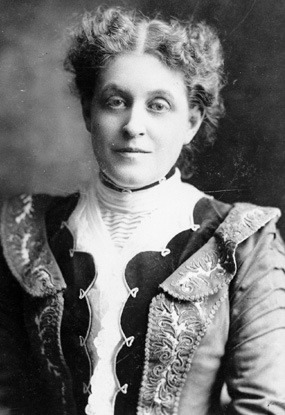A photograph of women suffragist marchers, dating March 3, 1913 (Library of Congress)
The characters of Iron Jawed Angels
Alice Paul:
Born: January 11, 1885
Died: July 9, 1977
Alice Paul was raised on a wealthy farm in the Quaker faith. She credits her Quaker faith, which promotes gender equality, and her mother, who was a member of the National American Women Suffrage Association, for her strong beliefs. Alice was a frequent visitor to National American Women Suffrage Association (NAWSA) meetings while attending with her mother. Alice’s mother frequently entertained many suffrage visitors at her home. Alice’s mother was a strong role model for Alice, when asked about her mother and why she was devoted her life to fighting for women’s rights in an interview Alice replied, "When you put your hand to the plow, you can't put it down until you get to the end of the row.” Alice learned many of her suffrage fighting techniques while attending school in England. She learned from the British women who used militant techniques. She was arrested a few times and engaged in hunger strikes while fighting for women’s rights in England. While engaging in hunger strikes she was force fed. In the movie, Alice is seen being force fed. Alice earned the following degrees:
B.A. in Biology from Swarthmore College, 1905
M.A. in Sociology from University of Pennsylvania, 1907
Ph.D. in Economics from University of Pennsylvania, 1912
LL.B. from Washington College of Law, 1922
LL.M. from American University, 1927
D.C.L. from American University, 1928
As seen in the movie Alice left the NAWSA and formed the National Women’s Party (NWP) she used the militant techniques she learned from her time in England and applied them to her fight for women’s rights in America. As portrayed in the movie, Alice and women eventually won the battle for equality for women with the passage of the nineteenth amendment. As with most influential people in history, Alice was the perfect lady to lead the movement for her time period. Her work ethic coupled with her experiences made her a very effective and influential leader for women’s rights. The movie portrays the character of Alice pretty accurately except for one point. Alice was a devout Quaker and therefore did not engage in alcohol consumption. The scene of the movie where she is seen at a bar with Inez Milolland consuming alcohol is false.
Lucy Burns:
While studying in England Lucy Burns and Alice Paul met. Both Alice and Lucy had been arrested after a suffrage demonstration and became friends. Burns joined the WSPU in 1909 where she became an effective street speaker. Lucy worked as a suffrage organizer in Scotland from 1910-1912.
After breaking away from NAWSA, Lucy helped create the National Women’s Party. The Library of Congress says "Burns organized campaigns in the West (1914, 1916), served as NWP legislative chairman in Washington, D.C., and, beginning in April 1914, edited the organization’s weekly journal, The Suffragist."
Burns picketed the White House and was imprisoned in the Occoquan Workhouse. Burns, along with fellow suffragists, was placed in solitary confinement after going on hunger strikes in 1917. November 15, 1917 has been dubbed the “Night of Terror,” because Burns was beaten, her arms were handcuffed above her head, and she was force-fed. Lucy Burns “spent more time in jail than any other suffragist in America or England.” While picketing in front of the White House, Lucy was arrested and eventually imprisoned in the Occoquan Workhouse. The scene in the movie in which Lucy was handcuffed above her head and beaten is accurate. This incident was called the “Night of Terror”.
Inez Milholland:
Inez Milholland began as a lawyer and eventually became a social activist. Milholland was also involved in abolition of the death penalty as well as her significant part in the fight for women’s suffrage. Milholland was a member of the Women’s Trade Union League, the NAACP, and the Fabian Society of England. In the film Milholland led a suffrage parade while riding a white horse in Washington, this scene is accurate and Millholland also led another parade while riding a white horse in New York. Milholland went on a speaking tour all over the country to help spread the word about women’s suffrage. Milholland had a medical condition called pernicious anemia. The doctor warned her and said she needed rest. She ignored the doctor’s advice toured anyways. On October 19, 1916, in Los Angeles, Milholland collapsed and later passed away ten weeks later on November 25. According to the Alice Paul Institute, “She was the first woman to be given a memorial service in the U.S. Capitol, a Christmas Day service attended by 10,000 or more mourners.” In the film the death of Millholland was presented and framed to happen immediately after her collapse. As mentioned above, this portrayal is false as she passed away ten weeks after the initial collapse.
Ruza Wenclawska (aka Rose Winslow):
Winslow was of Polish decent immigrated to the United States of America as an infant. At the early age of eleven Ruza began working in factories, textile mills and many different shops. Winslow participated in White House picketing and was imprisoned at the Occoquan Workhouse. While incarcerated at the Occoquan Workhouse Ruza was the first to join Alice Paul in a hunger strike.
Carrie Chapman Catt:
Carrie Chapman Catt was the head of field
organization for NAWSA. Carrie was a
founder and president of the International Woman Suffrage Association from
1904-1923. Carrie had a different approach to the fight for women’s suffrage,
Carrie believed in supporting the Democratic Party and President Wilson in an
effort to become allies in order to achieve suffrage. Carrie believed that by focusing individual
states would yield a faster less violent result than Alice Paul and the
NWP. Though Alice and Carrie had their
differences, Carrie’s role in focusing on the individual states was vital after
the amendment was proposed and needed two thirds of the state’s approval to be
enacted.
Director:
Katja von Garnier
Born: December 15, 1966
Responsible Film Making:
Direction of the movie is given to actors/actresses to fulfill the film to the best of their ability. They are to accomplish this by following historical evidence, portraying the characters accurately and fairly, cover more than one side of a story, and give the viewers an informative yet enjoyable experience.
Jason's Conclusion.
While directing the movie. the director had a very difficult choice to make when it came to selecting a cast that would be able to take the emotional issues presented, understand those issues and pass those emotions and feelings onto the big screen for all of us to see. Though one cant see the movie with a different cast, one can feel the emotion and power through the actresses. The film has a few moving scenes specifically where the audience can grasp the emotions at hand. The scene in which Alice speaks to the doctor because she is deemed "suicidal", is one of those scenes where the audience can feel the emotion and understands the impact these ladies had on our history. The film framed the women and their struggle very powerfully. The director also framed the U.S. government as a very powerful bunch of men who bullied the ladies at every direction. The film also potrayed Woodrow Wilson as a man who tried to do everything he could to avoid women's rights. In fact Woodrow Wilson had two daughters who considered themselves "suffragetts". Wilson also taught at a women's college. When finding out about the force feeding at the prison, Wilson was aghast and began to champion for their rights. Wilson acknowledged his debt to the suffrage fighters and said "we have made partners of the women in this war...Shall we admit them only to a partnership of suffering and sacrifice and toil and not to a partnership of privilege and right?". The director poorly frames Wilson as an anti women's right president. In the end, the director did an excellent job of presenting the issues and their importance to those championed in the film to us in a way in which one could understand the emotions and struggle that the women had to endure to receive their equal rights.
Actresses:
In the following clip one can see a short take on the importance of the roles and the effect the real suffrage fighters had on the actresses roles. Hilary Swank grew up with just her mother who sacrificed for her in many ways. This view of how strong women can be seen in the way she acts in the film. Swank narrated a documentary titled "The First Women of Film". Swank has a background of believing in strong women and had done other work with presenting the importance of women. A year later Swank won an Oscar for her role in "Million Dollar Baby", which is a movie about a strong willed female boxer. Swank's strong ties to women and her belief in herself and her mother can be seen in the acting she does in the film.
False Characters:
Senator Leighton and his wife Emily Leighton:
Ben Weissman.
This characters were false. Senator Leighton and his wife were used as a representation of certain groups of people. The Senator represented how many Senators believed at the time. Many Senators were against the proposal at first but with involvement and pressure from their wives and mothers helped them to see the other side. Ben Weissman seems to be a completely made up character who had no group representation. His role was added in the film for strictly Hollywood purposes of adding love and romance into a movie to meet certain other demographics and make the audience feel good.





